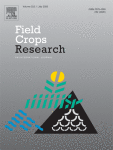Ver ítem
- xmlui.general.dspace_homeCentros Regionales y EEAsCentro Regional Buenos Aires SurEEA BalcarceArtículos científicosxmlui.ArtifactBrowser.ItemViewer.trail
- Inicio
- Centros Regionales y EEAs
- Centro Regional Buenos Aires Sur
- EEA Balcarce
- Artículos científicos
- Ver ítem
Sorghum biomass yield and allocation as affected by the combination of photoperiod sensitivity, sweet-stalk and brown midrib traits
Resumen
Context or problem: Traits like photoperiod sensitivity, sweet-stalk and brown midrib (bmr) have been introgressed to increase the biomass yield and quality of sorghum (Sorghum bicolor (L.) Moench) towards bioenergy yield improvement. The effects of combined traits on sorghum performance are far from clear.
Objectives: The objectives were to investigate the effects of different combinations of photoperiod sensitivity, sweet-stalk and bmr traits on
[ver mas...]
Context or problem: Traits like photoperiod sensitivity, sweet-stalk and brown midrib (bmr) have been introgressed to increase the biomass yield and quality of sorghum (Sorghum bicolor (L.) Moench) towards bioenergy yield improvement. The effects of combined traits on sorghum performance are far from clear.
Objectives: The objectives were to investigate the effects of different combinations of photoperiod sensitivity, sweet-stalk and bmr traits on sorghum biomass yield and allocation, and to discuss the implications of such effects on bioenergy production.
Methods: Data from our own as well as publicly available field trials were analyzed. A corpus of 51 hybrids grown in 49 environments were classified based on photoperiod sensitivity trait (PS or PI for photoperiod sensitive or insensitive), sweet-stalk trait (sweet- and sweet+), and bmr trait (bmr- and bmr+), and differences in the yields of shoot biomass and biomass fractions were determined. Biomass allocation was further evaluated in terms of allometric analysis.
Results: Significant triple interaction of the effects of the traits on shoot biomass and plant fractions yields were found. In PS-sorghum, bmr decreased shoot biomass only in sweet- genotypes. In PI-sorghum, sweet-stalk trait increased shoot biomass only in bmr- genotypes. In both PS and PI-sorghum, sweet–stalk and bmr traits drove changes in plants’ stem to leaves biomass ratio. In PI-sorghum they also promoted an increase of stem biomass at the expense of panicle biomass. Allometric analysis allowed us to capture different effects of traits on biomass allocation when the yield of biomass shoot changed.
Conclusions: Interaction among the effect of traits on shoot biomass yield help to explain discrepancies of biomass yield responses to traits found in the literature. Sweet-stalk and bmr traits produced changes in biomass distribution that depended on plant size, and that ultimately would impact on bioenergy production.
Implications or significance
Unraveling the mechanisms underlying biomass and quality changes in response to increasing biomass yield is essential to simultaneously improve bioconversion efficiency and biomass yield. This work provides a starting point for studying the mechanisms behind the effects of combined traits of agronomic interest on biomass yield and allocation of sorghum as an energy crop.
[Cerrar]

Fuente
Field Crops Research 305 : 109186 (January 2024)
Fecha
2024-01
Editorial
Elsevier
ISSN
0378-4290 (Print)
1872-6852 (Online)
1872-6852 (Online)
Documentos Relacionados
Formato
pdf
Tipo de documento
artículo
Proyectos
(ver más)
INTA/2019-PE-E7-I149-001, Bioenergía generada en origen como aporte al desarrollo territorial
Palabras Claves
Derechos de acceso
Restringido
 Excepto donde se diga explicitamente, este item se publica bajo la siguiente descripción: Creative Commons Attribution-NonCommercial-ShareAlike 2.5 Unported (CC BY-NC-SA 2.5)
Excepto donde se diga explicitamente, este item se publica bajo la siguiente descripción: Creative Commons Attribution-NonCommercial-ShareAlike 2.5 Unported (CC BY-NC-SA 2.5)


